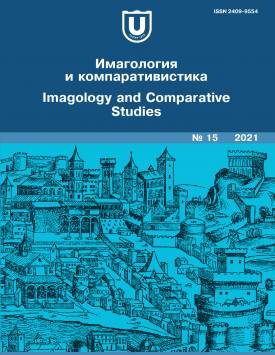The Goldfinch at Eastern Europe’s Crossroads: Russian Subtexts of Donna Tartt’s Novel
Attention to the western reception of Eastern Europe has been relevant for several centuries, but it is especially characteristic of the turn of the 21st century. The inertia of the Cold War is still felt in popular culture: evil is essentialized in the images of Russia/Eastern Europe and Russians/Eastern Europeans every time. Another tradition prefers to create the image of a Russian relying on the harmless, inactive characters of Russian fairy tales and novels, such as Emelya and Oblomov. Russia itself is often not named or portrayed in films and texts; it is replaced by Eastern Europe, Siberia, and fictional cities. The article highlights the main characteristics of the Eastern European text according to Larry Wolff: remoteness, coldness, savagery, passionateness, ambivalence, theatricality, frightening suspense. Eastern European images by the contemporary American writer Donna Tartt (Boris Pavlikovsky and other Slavs in her novel The Goldfinch) are compared with the interpretation of such images in the popular culture and by the writers of the 20th century (in William Somerset Maugham’s novel The Razor’s Edge). In Tartt’s novel, we encounter heroes who are not just interested in Russia and Russians/Eastern Europeans, but are literally fascinated by them, trying to learn the language, study Russian literature. It has been suggested that Fyodor Dolokhov from Leo Tolstoy’s War and Peace, one of the key novels in the world literary tradition, could be the prototype for a significant number of Eastern European images. This ambivalent image combines all the main characteristics of the Eastern European text and allows both negative (most often) and positive (with careful consideration of the plots and characteristics) interpretations. For example, coldness, winter, blizzard can be considered as negative characteristics (especially considering some connotations), but, in the classic novel, which is also oriented towards Dickens, they are naturally connected with the Christmas theme of the miraculous elimination of contradictions, the fabulous resolution of all problems, and transformation. Therefore, it is not surprising that the “code” of the character is repeated, from name to separate themes and motifs. The characteristics Wolff lists - robbery, philosophizing, masquerading, duality - generate both repulsion and attraction. It is possible that the positive perception of Eastern Europe is rooted in the approach to the theme through the prism of literature and literary criticism. Tartt as a philologist is expectedly more influenced by modern literary theory inspired by the formalists, Propp, Bakhtin, Jakobson, and Lotman, than by political cliches.
Keywords
Donna Tartt, Leo Tolstoy, Eastern Europe, Orientalism, receptionAuthors
| Name | Organization | |
| Gevel Olga E. | Sibirian Federal University |
References

The Goldfinch at Eastern Europe’s Crossroads: Russian Subtexts of Donna Tartt’s Novel | Imagologiya i komparativistika – Imagology and Comparative Studies. 2021. № 15. DOI: 10.17223/24099554/15/16
